BUECO5903 Business Economics Assignment Help
Question 1:
Consider a macroeconomy was initially at equilibrium. Using an aggregate demand and aggregate supply diagram model of the economy, graphically illustrate and discuss the short-run and long-run effects of the following events upon the economy:
(a) The imposition of a carbon tax upon local big polluting companies.
(b) An appreciation in the foreign exchange rate value of the economy's currency.
(c) The European economies all fall into recession
(d) The country's main exports fall in price while the goods the country imports from abroad rise in price
Question 2:
2a. State the difference (IN YOUR OWN WORDS) between:
- Absolute advantage and comparative advantage.
- The terms of trade and the exchange rate
- A demand side shock and a supply side shock
- A trade surplus and a budget surplus
OR
2b. State the difference between:
- uncertainty and risk.
- between the interest rate and the exchange rate
- between a supply side shock and a demand side shock
- between a trade deficit and net foreign debt (2 marks)
Question 3
Use the Australian Bureau of Statistics website and perhaps the Reserve Bank of Australia website to answer the following questions: What are the current levels of the following economic indicators in the Australian economy? (Remember these should be expressed in annual terms)
Inflation
Unemployment
Economic growth rate
The cash rate
The Australian dollar exchange rate
Question 4
Use the aggregate demand- aggregate supply diagram model to explain the consequences in terms of price level and real GDP of a decline in aggregate demand as shown by:
(a) Classical economics
(b) Keynesian economics
Why did the classical economists believe the economy would always find equilibrium at full employment and the Keynesians did not?
Question 5
Assume an economy operates on the middle part of its aggregate supply curve. State the direction of effect on aggregate demand or aggregate supply for each of the following changes in conditions. What is the effect on the price level, real GDP and employment? Use diagrams in your answer.
(a) The price of crude oil rises significantly
(b) Spending on welfare and aged pensions doubles
(c) The value of the currency falls on the foreign exchange market. i.e the currency depreciates
(d) The Government halves the goods and services tax (GST) on all consumer goods
(e) The Government announces rises in company tax. (2 marks per part)
Question 6
If you wanted to increase aggregate demand how would you do it for the following:
Consumption demand
Investment demand
Net exports
Which of the three components also has an impact upon the Aggregate supply side of the economy?
Question 7
Consider a macroeconomy was initially at equilibrium level of real GDP.
Using an aggregate demand and aggregate supply diagram or model of the economy, graphically illustrate and discuss the short-run consequences of the following events upon an economy:
(a) The Central Bank within the economy lifts interest rates.
(b) There is an increase in private domestic investment spending.
(c) An increase in the good and services tax (GST)
(d) An appreciation or rise in the foreign exchange rate value of the economy's currency.
(e) A fall in real estate prices in the capital cities of the country
Question 8
Why are quarterly movements in a country‘s GDP measure so important? What is it called when a country has two successive negative quarters of economic growth? When the economy is heading into a recession what economic policy instruments can the government and the central bank use to prevent this from occurring? Will these instruments work to prevent the onset of recession?
We Help Students to improve their grades! Avail TOP Quality BUECO5903 Business Economics Assignment Help and Homework Writing Services at Cheaper Rate!
Ans 1:
In the following graph
Original Equilibrium: Point A
The given Price Level is P0
Real GDP is given as Y0
(a)
Imposition of carbon tax will increase cost of production, so firms will lower output, decreasing aggregate supply. SRAS curve will shift to left, increasing price level and therefore decreasing real GDP (situation called stagflation). In the graph given below, SRAS curve will move left from SRAS0 to SRAS1, intersecting AD0 at point B with lower real GDP Y1 & a higher price level P1(Pettinger, 2017)
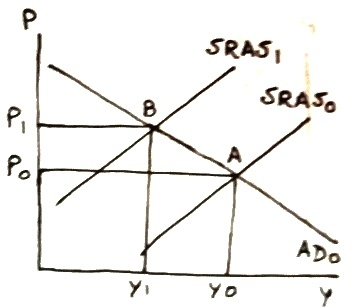
(b) Appreciation of domestic currency decreases exports and increases imports, decreasing aggregate demand & net exports. This shifts AD curve towards its left and decreases both real GDP & price level. In the given graph, AD curve will move leftward from AD0 to AD1, intersecting SRAS0 at point B with lower price level P1 and lower real GDP Y1. (Pettinger, 2017)
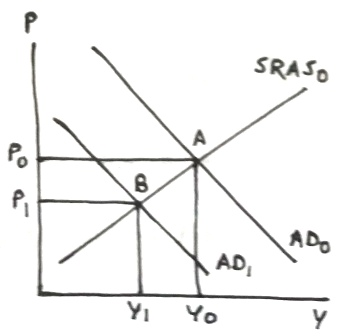
(c)
Import demand will decrease and therefore US export demand will also decrease as a result of recession in European economies. It will lead to decreasing net exports & decreasing aggregate demand. This shifts AD curve towards left and decreases both price level and real GDP. In the given graph, AD curve will move towards left from AD0 to AD1, intersecting SRAS0 at point B with lower price level P1 and lower real GDP Y1. (Pettinger, 2017)
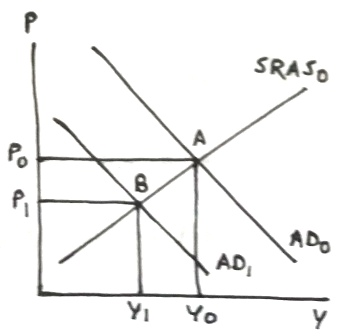
(d)
Lower price of exports and higher price of imports will increase exports and decrease imports, increasing aggregate demand & increasing net exports. This moves AD curve towards its right and leads to an increase in both Real GDP and price level. In the given graph, AD curve will move towards its right from AD0 to AD1, intersecting SRAS0 at point B with higher real GDP Y1 & a higher price level P1. (Pettinger, 2017)
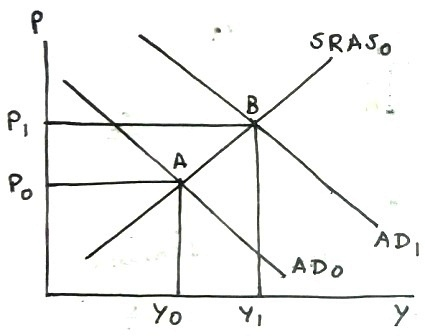
Ans 2a:
1. Absolute advantage is the capability to produce more of any product by using less of resources than the competing party. While comparative advantage takes into contemplation the opportunity cost involved in manufacturing any product, it sees which party can produce any product with lower opportunity cost. Countries use comparative advantage for trade (Courses.lumenlearning.com, 2019)
2. Terms of trade is the price at which the product can be exchanged i.e. exported or imported. While exchange rate is rate at which one countries currency is priced in terms of other countries currency. (Economics Discussion, n.d.)
3. Shocks are unexpected events. Demand side shock refers to the sudden unexpected events which can decrease or increase the demand, like tax increase. While supply side shock affects short run aggregate supply and hence long run productivity, like political turmoil, natural disaster etc. (Khan Academy, n.d.)
4. Trade surplus shows the positive balance of trade. It measures, by how much the export exceeds the import. Budget surplus is the amount by which the receipts exceed the expenditure or simply put, it is positive income of a country. (Econlib, n.d.)
Ans 3:
Current level of indicators mentioned below are as follows:
Inflation : 1.6% (June 2019)
Unemployment : 5.3%
Economic Growth Rate : 0.5%
The Cash Rate : 1%
The Australian Dollar Exchange Rate : 1 USD = 0.6762 AUD (As of 27 September 2019) (Reserve Bank of Australia, 2019)
Ans 4:
Classical economists believed that economy enters into full employment without inflation due to automatic competitive forces while Keynesian believe that government interference is not necessarily taken to render full employment scenario.
Classical economists believed in monetary policy development and keynesian economists believed in fiscal policy development.
For decline in aggregate demand, the consumption also declined and hence the Prices fall causing the real GDP to decrease. Classical economists would apply contractionary monetary policy while Keynesian economists would apply contractionary fiscal policy to decrease the inflationary pressures. (Jahan, Mahmud & Papageorgiou, 2014)
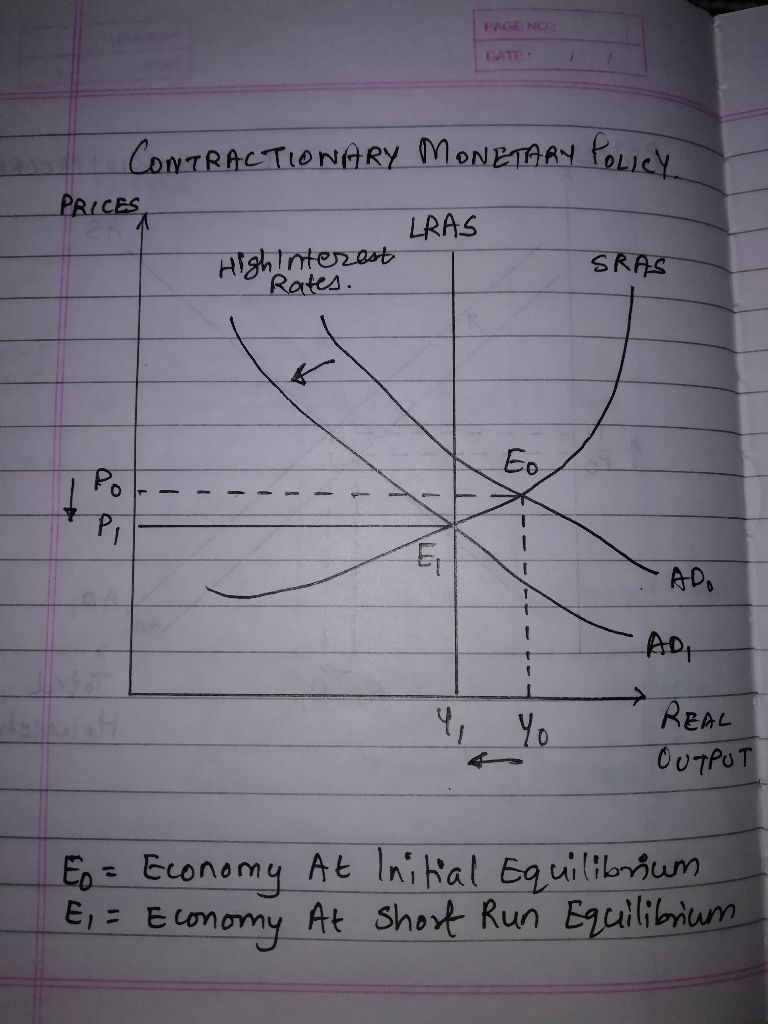
Ans 5
In the given graphs:
Original equilibrium : A
Initial equilibrium price is given by P0
Real GDP is given by Y0.
(a)
An increase in oil price will increase cost of production, so firms will lower output, decreasing aggregate supply. SRAS curve will shift to left, increasing price level and decreasing real GDP (situation called stagflation). In the given graph, SRAS curve will move towards left from SRAS0 to SRAS1, intersecting AD0 at point B with higher price level P1 and lower real GDP Y1. (Courses.lumenlearning.com, n.d.)
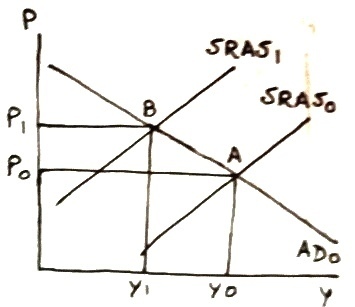

(b)
Higher government spending will increase aggregate demand, shifting AD curve towards right and increasing both real GDP and price level. In the given graph, AD curve will move towards its right from AD0 to AD1, intersecting SRAS0 at point B with higher real GDP Y1. & price level P1 (Courses.lumenlearning.com, n.d.)
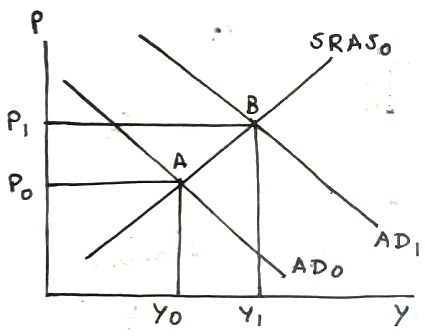

(c)
Depreciation of domestic currency increases exports and decreases imports, increasing net exports & decreasing aggregate demand. This shifts AD curve towards left and decreases both real GDP & price level. In the given graph, AD curve will shift leftward from AD0 to AD1, intersecting SRAS0 at point B with lower real GDP Y1& lower price level P1. (Pettinger, 2017)
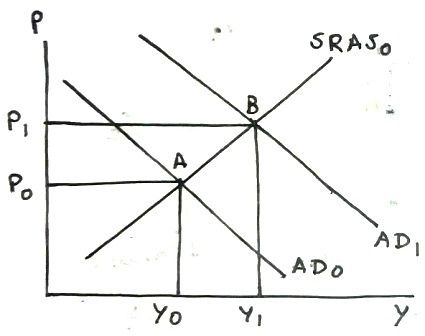
(d)
A decrease in GST will decrease business cost, so firms will increase output, increasing aggregate supply. SRAS curve will move to right, increasing real GDP & decreasing price level. In the given graph, SRAS curve will move right from SRAS0 to SRAS1, intersecting AD0 at point B with higher real GDP Y1 & lower price level P1.
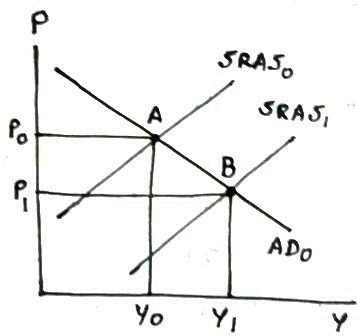

(e)
An increase in company tax will increase cost of production, so firms will lower output, decreasing aggregate supply. SRAS curve will shift to left, decreasing real GDP & increasing price level (situation called stagflation). In the given graph, SRAS curve will move left from SRAS0 to SRAS1, intersecting AD0 at point B with lower real GDP Y1 & higher price level P1.
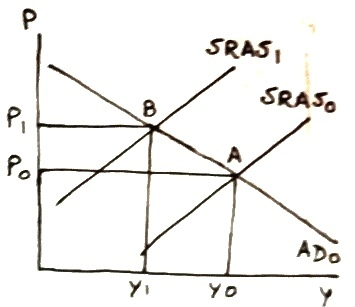
Hire professional writer from Expertsminds.com and get best quality BUECO5903 Business Economics Assignment Help service and homework writing services now!